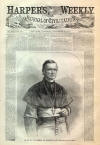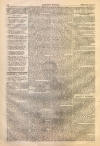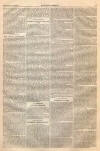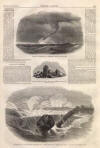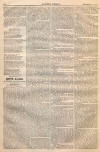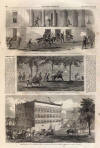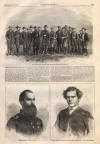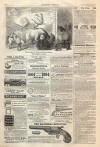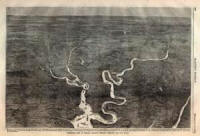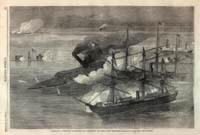Archbishop McCloskey
|
|
This Site:
|
VOL. VIII.óNo. 402.] NEW YORK, SATURDAY, SEPTEMBER 10, 1864. SINGLE COPIES TEN CENTS. $ 4.00 PER YEAR IN ADVANCE. Entered According to Act of Congress, in the Year 1864, by Harper & Brothers, in the Clerk's Office of the District Court for the Southern District of New York. ARCHBISHOP McCLOSKEY.WE give on this page a portrait of' the Reverend JOHN McClOSKEY, the successor of JOHN HUGHES in the Archbishopric of New York. Formerly the bishop of the diocese of Albany, Dr. M'CLOSKEY was known as one of the most polished and eloquent orators of the Roman Catholic Church in the United States. He was born in Brooklyn, New York, and after the usual course of education was ordained a priest. On the 10th of March, 1844, he was ordained Bishop of Axieren and coadjutor to Dr. HUGHES, then Bishop of New York. Three years later he became the Bishop of Albany, being the first prelate of that see, as the diocese was then first established. St. Mary's, one of the four Catholic Churches of Albany, he made his cathedral. In the entire diocese there were about forty churches, some of them without a regular clergyman. The Catholic population were scattered over a large territory, were for the most part poor, and had to struggle against the prejudices of the surrounding people. Dr. M'CLOSKEY had therefore no easy task before him in carrying out his zealous plans for the Catholic Church. But he went to work with earnestness. One of the bishop's first projects was the institution in Troy of a Female Orphan Asylum, which he placed under the control of the Sisters of Charity. In 1851 the Christian Brothers opened the Academy of Saint Joseph in the same town; and the sane year the Sisters of Charity opened a hospital which has in a single year received 789 patients. The next year a Female Seminary was founded in Albany by a colony of the Sisters of the Sacred Heart. In 1855 Dr. M'CLOSKEY opened in Utica an Academy for boys, at the cost of more than $17,000. The diocese of Albany includes all of the State of New York lying north of forty-two degrees north and east of the eastern line of Cayuga, Tompkins, and Tioga counties. After a service of seventeen years Dr. M'CLOSKEY left in this diocese one hundred and thirteen churches, eight chapels, fifty-four minor stations, eighty-five missionaries, three academies for boys and one for girls, six orphan asylums, and fifteen parochial schools. If the new Archbishop of New York leaves as good a record as he has left as Bishop, the Catholic Church will surely have no reason to regret the Pope's selection of JOHN HUGHES'S successor. On Sunday, August 21, the Reverend JOHN M'CLOSKEY was installed as the Archbishop of the Catholic diocese of New York, the ceremonies on that occasion being performed in St. Patrick's Cathedral. If Dr. M'CLOSKEY succeeds as well as his predecessor in making his influence tell for good, both the Country and the Church will have occasion for congratulations. ISOMETRIC VIEW OF THE VIRGINIA CAMPAIGN.On page 580 we print a Map giving an ISOMETRIC VIEW OF THE REGION AROUND PETERSBURG. In the foreground is City Point and the region north of the James, which has so lately been the theatre of GRANT'S movements. At Dutch Gap General BUTLER is digging a canal, which, as the reader will see, must very much shorten the course of the James at this point. Off to the left, southward of Petersburg, stretch the Federal lines across the Weldon Railroad. Further to the left is the Danville Road, which has two branches from Burkesville Junction eastward, one running to Petersburg, and the other to Richmond. This view does not include Burkesville Junction. FRANCIS MULLER, THE MURDERER, FROM LONDON.INTENSE popular excitement prevailed in New York August 24, when it was announced that the London murderer had arrived in the packet-ship Victoria. There was nothing in the murderer himself to account for this excitement, which was due rather to the peculiar circumstances attending his crime, and the somewhat extraordinary manner in which the detection of the criminal was brought about. The crime was committed on the 9th of July, in a first-class carriage on the North London Railway. English railcars are very different from those to which we are accustomed in this country. The carriages are divided into separate compartments; and it is frequently the case that only one person is the sole occupant of a compartment. On the day above mentioned Mr. Briggs, chief clerk in a city bank, and residing at Hackney, took a compartment in a first-class train from London to his place of residence. The train arrived at Hackney without him that night. As it reached the station a person opening the door of No. 69, which was Mr. Briggs's room, and placing his hand upon the seat found it covered with blood. He also found in the room a gentleman's hat, walking - stick, and a small leathern bag. Ladies in the adjoining compartment gave notice to the guard that in some way blood had been spurted upon their dresses from this same bloody room. At the same time Briggs was being picked up back on the road, and carried almost senseless to Mitford Castle Tavern. Four and one half pounds in gold was found in one of his pockets, and a silver snuff-box in another. A diamond ring was also found on his person. From these circumstances it was evident that Briggs had been murdered and then thrown out of the car by some person who had that night occupied No. 69 with him. Who was the murderer? This was the question which for days agitated the popular heart of London. There seemed to be but a single clew: Briggs's watch had been taken. The murder was committed Saturday evening. The next Monday evening a gentlemanly looking foreigner, apparently a German or Swiss, entered the shop of one Mr. Death, a silversmith on Cheapside, and asked to be shown some gold Albert chains. He finally selected one to suit him, and took from his waistcoat pocket another chain, and asked Mr. Death what he would give for it. It proved that there was five shillings' balance in the foreign gentleman's favor, which balance was covered by a ring. Mr. Death packed up the chain in a paper box and delivered it to his customer, who then walked out. That foreign gentleman was the murderer for whom the London police were in search, and this barter of his with Mr. Death led to his detection. After leaving the jeweler's office he proceeded to his residence in Bow Street, and made arrangements for coming to New York in the Victoria. The little daughter of the cabman discovered the paper box in his room after he left, and showed it to her father. This box had Mr. Death's address on the inside, and this, with collateral evidence from a great number of sources, made it certain that Francis Muller was the murderer. He had taken passage in (Next Page) THE MOST REV. JOHN McCLOSKEY, D.D., ARCHBISHOP OF NEW YORK. - [PHOTOGRAPHED BY MATHEW BRADY.] 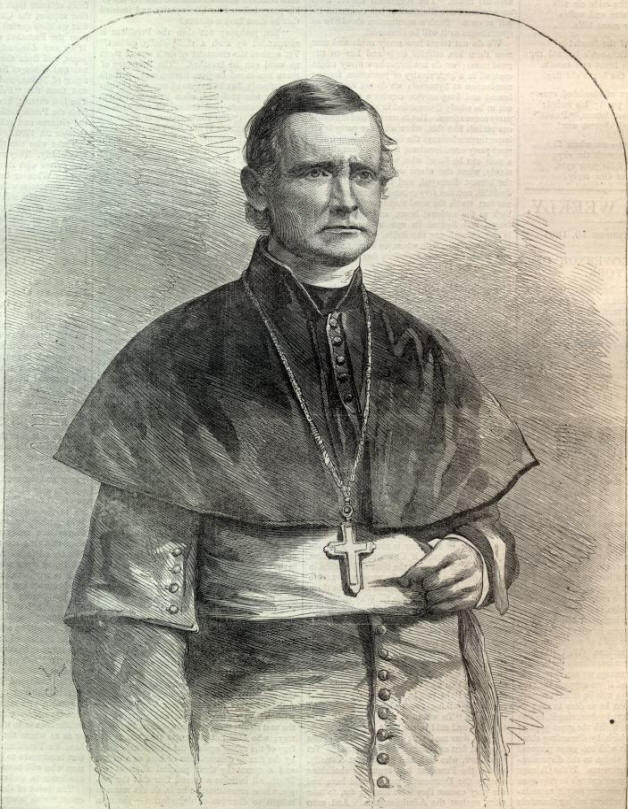 We acquired this leaf for the purpose of digitally preserving it for your research and enjoyment. If you would like to acquire the original 140+ year old Harper's Weekly leaf we used to create this page, it is available for a price of $195. Your purchase allows us to continue to archive more original material. For more information, contact paul@sonofthesouth.net |
||||||||||||||||||||||
|
|
||
|
|
Site Copyright 2003-2018 Son of the South. For Questions or comments about this collection, contact paul@sonofthesouth.net |
|
|
Are you Scared and Confused? Read My Snake Story, a story of hope and encouragement, to help you face your fears. |
||
